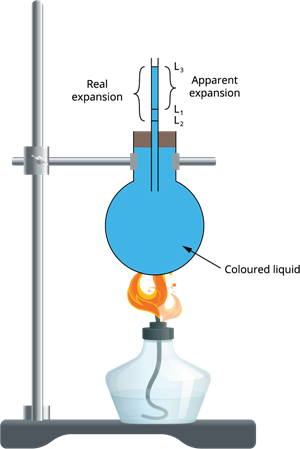
PUMPA - SMART LEARNING
எங்கள் ஆசிரியர்களுடன் 1-ஆன்-1 ஆலோசனை நேரத்தைப் பெறுங்கள். டாப்பர் ஆவதற்கு நாங்கள் பயிற்சி அளிப்போம்
Book Free DemoReal expansion:
When liquid is heated directly without using any container or vessel, the expansion that you observe is termed the real expansion of the liquid.
When liquid is heated directly without using any container or vessel, the expansion that you observe is termed the real expansion of the liquid.
The coefficient of real expansion is defined as the ratio of the actual rise in the liquid's volume per degree rise in temperature to its unit volume.
The SI unit of coefficient of real expansion is .
The SI unit of coefficient of real expansion is .
Apparent expansion:
It is not possible to heat a liquid without using a container or vessel. Thus, practically, you can heat any liquid by pouring it into a container or vessel.
It is not possible to heat a liquid without using a container or vessel. Thus, practically, you can heat any liquid by pouring it into a container or vessel.
A portion of thermal energy is used to expand the container, and a portion is used to expand the liquid. Thus, the observations are not the liquid's actual or real expansion.
The expansion of liquid apparently observed without considering the expansion of the container or vessel is called the apparent expansion of the liquid.
The expansion of liquid apparently observed without considering the expansion of the container or vessel is called the apparent expansion of the liquid.
The coefficient of apparent expansion is defined as the ratio of the apparent rise in the liquid's volume per degree increase in temperature to its unit volume.
The SI unit of coefficient of apparent expansion is .

Real and Apparent expansion
Liquids are different from solids with no fixed length or surface area but always take up the shape of the containing vessel.
When the liquid in a container is heated, heat flows to the liquid through the container. It shows that the container expands initially, due to which the level of the liquid falls.
Further, the liquid is heated, it expands more beyond its level. We cannot observe the intermediate state. We can only see the initial and final levels. This observed expansion of the liquid is known as the apparent expansion of the liquid.